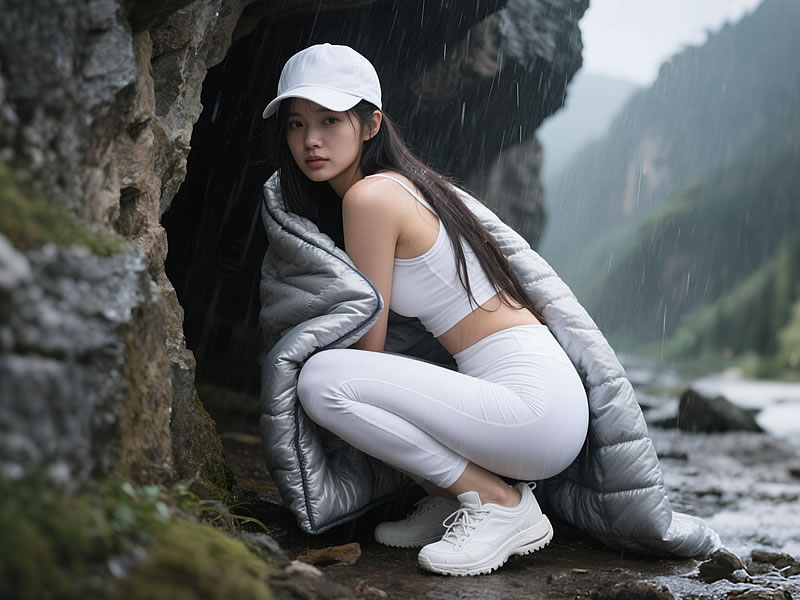How to stay warm with minimalist lightweight gear?
Staying warm in the wilderness doesn’t require bulky gear or heavy layers—modern ultralight materials and smart layering techniques can keep you cozy even in freezing temperatures. This guide combines thermal science, gear recommendations, and pro hacks to help you master cold-weather camping with a minimalist pack.

The Science of Staying Warm: Heat Retention Basics
Heat escapes through conduction (contact with cold surfaces), convection (wind), radiation (body heat loss), and evaporation (sweat). Ultralight strategies target these pathways:
- Insulate from the Ground: 50% of body heat is lost via conduction.
- Block Wind and Moisture: Windproof shells reduce convective cooling.
- Trap Radiant Heat: High-loft materials (down, synthetic fibers) create warm air pockets.
- Manage Moisture: Sweat-wicking base layers prevent evaporative chilling.
Layering System: The Ultralight Trio
1. Base Layer: Moisture Management
- Material: Merino wool (e.g., Smartwool 150) or synthetic (e.g., Patagonia Capilene).
- Weight: 4–6 oz (113–170g).
- Why: Wicks sweat, dries fast, and resists odors. Avoid cotton—it traps moisture.
2. Mid Layer: Active Insulation
- Options: Fleece (e.g., Polartec Alpha Direct, 3.5 oz) or down/synthetic vest.
- Weight: 5–8 oz (142–227g).
- Why: Retains heat during movement; breathable to prevent overheating.
3. Outer Layer: Wind/Rain Protection
- Options: Wind jacket (e.g., Montbell Tachyon, 1.9 oz) or rain shell (e.g., Frogg Toggs UltraLite2, 5.3 oz).
- Why: Blocks windchill and precipitation; packs smaller than insulated jackets.
Sleep System: Lightweight Warmth Essentials
1. Sleeping Bag/Quilt
- Down: Higher warmth-to-weight ratio (e.g., Enlightened Equipment Revelation 20°F, 19 oz).
- Synthetic: Better for damp conditions (e.g., Nemo Forte 20, 33 oz).
- Pro Tip: Use a liner (e.g., Sea to Summit Thermolite, 8 oz) to boost warmth by 10–15°F.
2. Sleeping Pad
- R-Value: Aim for R 4+ (e.g., Therm-a-Rest NeoAir XTherm, R 6.9, 15 oz).
- Budget Hack: Pair a foam pad (R 2, 10 oz) with an inflatable pad (R 3).
3. Tent/Weather Shield
- Condensation Control: Single-wall tents (e.g., Zpacks Plexamid, 15 oz) with vents reduce interior moisture.
- Emergency Option: A 3 oz SOL emergency bivy adds 10°F of warmth.
5 Pro Hacks for Extreme Cold
1. Hot Water Bottle
Fill a Nalgene with boiling water, wrap in a sock, and place in your sleeping bag. Adds 2–3 hours of warmth.
2. Calorie Bombing
Eat high-fat snacks (nuts, chocolate) before bed—digestion generates internal heat.
3. Vapor Barrier Liners (VBL)
Wear a thin plastic layer (e.g., bread bag) over socks/gloves to block sweat from soaking insulation.
4. Strategic Campsite Selection
- Avoid valleys (cold air sinks).
- Pitch tents in tree-covered areas to block wind.
5. Chemical Warmers
Place disposable warmers (e.g., HotHands) in gloves, boots, or core areas.
Gear Weight vs. Warmth: Budget-Friendly Options
| Item | Lightweight Pick | Weight | Temp Rating | Price |
|---|---|---|---|---|
| Sleeping Bag | Hammock Gear Economy Burrow | 24 oz | 20°F | $220 |
| Puffy Jacket | Decathlon Trek 100 | 10.9 oz | N/A | $50 |
| Sleeping Pad | Klymit Static V Insulated | 25 oz | R 4.4 | $80 |
3 Deadly Mistakes to Avoid
- Over-Tightening Layers: Compressed insulation (e.g., tight straps over a puffy) reduces loft and warmth.
- Breathing into Your Bag: Exhaled moisture dampens insulation—use a balaclava instead.
- Ignoring Humidity: Down loses insulating power when wet; synthetic is safer in damp climates.
SEO-Optimized Takeaways
- Keywords: Include “ultralight winter gear,” “lightweight camping warmth,” or “cold-weather sleep system.”
- User Intent: Answer FAQs like “Can you stay warm with a 20°F sleeping bag?” or “How to layer for sub-freezing temps?”
- Readability: Use bullet points, bold terms, and comparison tables.
Final Thoughts
Staying warm with minimalist gear hinges on understanding heat dynamics and prioritizing high-performance materials. Focus on a three-layer clothing system, a sleep setup with R 4+ insulation, and clever field tricks like hot water bottles. By balancing weight and warmth, you’ll conquer cold nights without sacrificing mobility or adventure.






